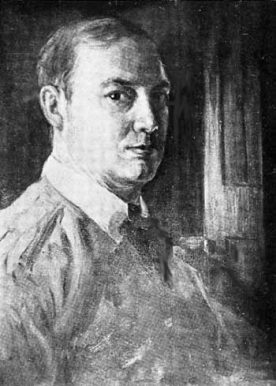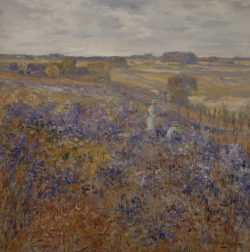Alfred Juergens, Self-Portrait, undated, unlocated painting, published in Austin, Oak Park and River Forest Art League, The Art League Book (Oak Park, IL: The League, 1940), p. 16

Alfred Juergens 1866–1934
The son of a house paint merchant, Alfred Juergens was born in Chicago. After studies at the Chicago Academy of Fine Arts (predecessor of the Art Institute of Chicago), Juergens went to Munich in 1884 to enroll in its Royal Academy. After six years of study there he began exhibiting with success in European exhibitions and spent several years in Paris. Returning to Chicago in 1892, Juergens worked on the World’s Columbian Exposition of 1893, likely as a mural or decorative painter. Back in Munich in 1895, he was elected to several German artists’ organizations. Four years later, Juergens settled permanently in the Chicago suburb of Oak Park, Illinois, where his father had built a house. He made numerous excursions to Europe over the following decades, visiting France, England, Holland, and Austria.
Juergens’s international training and exhibition success gave him instant credibility in the Chicago art scene. On his return to his native city in 1899 the Art Institute gave him a widely reviewed solo exhibition that was among the museum’s first for a living artist. In the course of his career, Juergens was the subject of several other solo shows in local institutions and he participated in many more group exhibitions, especially at the Art Institute. His numerous prizes included a bronze medal at the Panama-Pacific International Exposition in San Francisco in 1915.
Juergens’s early paintings show the influence of his Munich training in their dark tones, interior settings, and themes of peasant life treated in genre scenes and portraits of rural character types. In Chicago he also painted decorative murals and formal commissioned portraits. From the beginning, however, he showed a particular penchant for landscape paintings, favoring garden-like settings that he often enlivened with figures; he also painted several scenes of downtown Chicago. Adept in both oils and watercolors, Juergens turned to the bright color, outdoor light effects, and broken brushwork associated with impressionism after a stay in Paris in the early years of the twentieth century. He painted many views in his hometown of Oak Park, where he was active in local art affairs. He made frequent excursions to paint in western Michigan, marrying a Grand Rapids native late in life. Remembered as “brilliant, tempestuous and eccentric,” Juergens was an “American Monet.”i Yet a cache of his late works discovered in his widow’s Michigan farmhouse in 1949 apparently demonstrated that Juergens had eventually moved beyond impressionism.
Wendy Greenhouse, PhD
i “Discovery of Priceless Art Solves 15-Year-Old Mystery,” Battle Creek Enquirer, July 12, 1949; “Widow of Juergens Willing to Exhibit His Paintings Here, Chicago Tribune, July 18, 1949.
